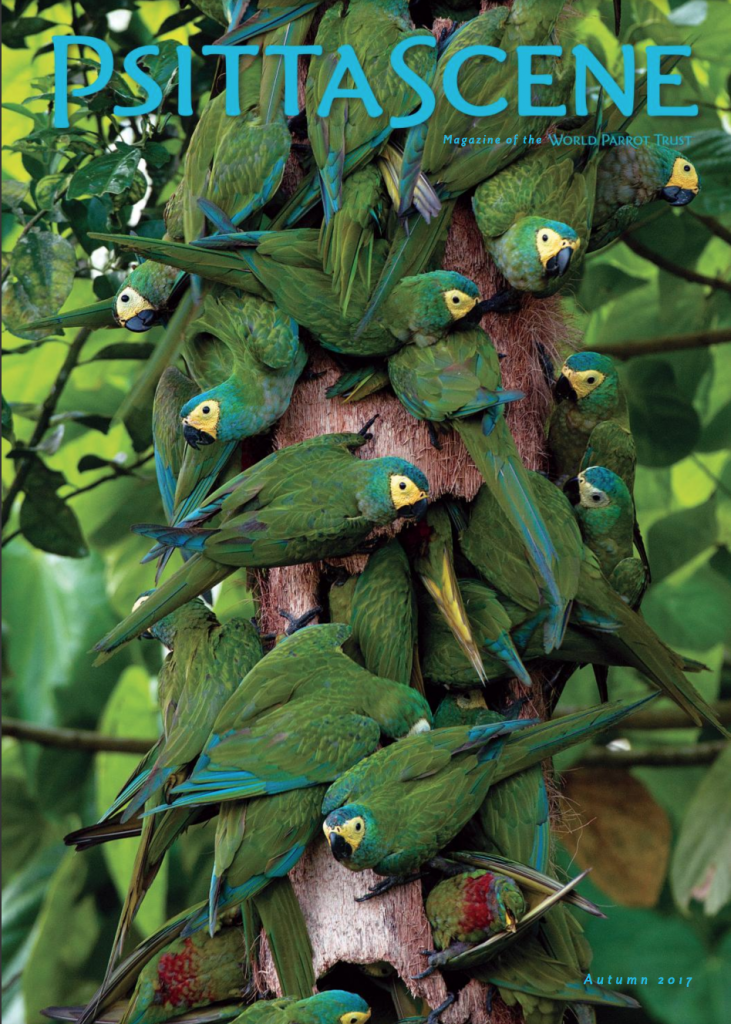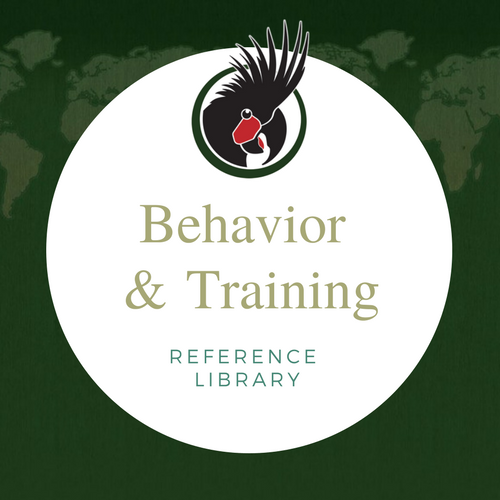
The Parrot That Screams
That darned parrot is screaming its head off all the time. Your last nerve has just left the building. Your partner is threatening to leave you and your neighbors are complaining vehemently about the noise.
What can you do?
From the Summer 2015 Edition of PsittaScene Magazine. Get a free subscription with your WPT membership.
Before we go any further, we need to understand what exactly we mean by the word “screaming ” since that is the specific behavior we are interested in. When we talk about “screaming” parrots in this instance, we are speaking of loud, repetitive, sustained vocalizations from an otherwise normal healthy bird. Loud vocalizations from a bird that is ill fall into a different category and will not be addressed in this article. For the purposes of this article we will deal with the single bird. Multiple birds will have their own dynamic in play.
In the home situation, more often than not, screaming is the result of a contact call that has been supersized. How could that happen? Why would it happen? For a moment let’s forget about parrots and think about ourselves. Have you ever called to your children or your partner – and they didn’t answer? What did you do next? I’ll bet you raised your voice and called a little louder – and louder still if they again didn’t answer. The same process often applies to parrots who call those they live with using pleasant sounds that we either ignore, or don’t hear because our ear isn’t quite tuned into the background noise of sounds that don’t meet the annoyance factor particular to each of us. At that point, the parrot does the same thing that we do – it raises its voice to be heard. Simply put, we have inadvertently taught this parrot to scream louder and longer.
OK, now that we understand how a parrot can learn to scream in some situations, what can we do about it? Before we start throwing out fixes willy-nilly, we need to understand when the behavior occurs and what this particular bird gets when it screams. If we take a scalpel and remove all the editorial comments that we humans are prone to surround each behavior with, and look at what happens immediately before (antecedent) and immediately after (consequence) the behavior, we might see something like the following typical examples:
EXAMPLE 1:
Antecedent: Person leaves room
Behavior: Parrot screams
Consequence: Person opens door and says “shut up”
Prediction: The parrot will scream more
EXAMPLE 2:
Antecedent: Person comes home from work
Behavior: Parrot screams
Consequence: Person says hello quietly
Prediction: The parrot will scream more
Notice that in each of the examples, the bird gets something in ways we might not expect. In these two cases, what we might think is an action that will reduce the behavior is in actuality serving as what is called a positive reinforcer – a reward, from the parrot’s point of view, for screaming. The examples noted are functionally equivalent in that human attention is the maintaining factor in the consequence.
Since a bird and its living conditions in each home are unique, these scenarios give us some hypotheses that provide a glimmer of the function the behavior serves. What can we do about it? We can change what happens before the behavior occurs, reinforce sounds that the bird makes that we can live with, change what happens after the behavior occurs, or we can teach the bird some new behaviors so that it gets other more natural reinforcers. It is that simple and yet that complicated.
The length of time it takes to change the screaming behavior will vary. Screaming can be one of the most difficult behaviors to change, but it can be done – although it is a little labour intensive for the human in the beginning. Let’s take a look at some possible changes that we could work into our hectic schedules.
Antecedent changes
Before the screaming behavior occurs, we could:
• Provide the parrot with some one-on-one time. Chatting, grooming to remove feather sheaths in a moulting bird, or going for a safe and supervised wander around the home are some examples.
• If the bird is caged, move the cage or play stand to a safe area where there is a greater possibility to interact with the family.
• Provide foraging opportunities in the cage and on the play area to stimulate behaviors that might occur in the wild. Toy boxes can contain a part of the daily food allowance, treats and/or different types of foot toys. Depending on the bird, the boxes can be made of cardboard, wood, safe reeds, stainless steel or other non-toxic materials.
• Ensure that the parrot gets enough exercise, whether it be running, flying or some form of calisthenics. (Tired birds are less likely to scream.)
• Make it a practice to drop by the bird for a minute or two while the bird is behaving in an appropriate way. Taking a moment to say “Hi how are you?” can go a long way to pre-empting screaming behavior because we are providing that attention discussed above before the screaming occurs.
Consequence changes
If we want to reduce the amount of screaming that takes place, we can reinforce other behaviors that serve the same function as screaming.
• Pick some sounds the bird makes we can live with long term. Whistling, talking, soft sounds are always good candidates to choose and provide attention when those occur. That often means we will need to train ourselves to hear those sounds when they occur – listen for the soft pleasant contact calls and respond.
• Withdraw all form of attention when the bird is screaming.That is extremely hard for most of us to do as we will lose that last nerve discussed earlier and respond in some way with a look or some vocalization of our own. It is therefore not recommended to respond to the calls unless we are able to immediately catch the parrot being good the instant it stops screaming.
• Reinforce longer and longer durations of playing with toys, chewing on suitable materials, relaxing on the perch – or as in our house, laughing. Pick the behaviors you can live with long term and encourage them.
Teaching New Behaviors and Skills
The world our parrots inhabit and what we can teach it are endless. Any teaching at all will serve the function of providing the same attention discussed above, while also greatly increasing the overall amount of reinforcement in a bird’s daily life.
Whether this parrot needs to learn to step-up, forage, play with different types of toys, flap their wings, use the cage as a jungle gym, station to a specific perch, come when called, or enter a crate for transport, we can teach those behaviors. Useful behaviors can enrich a parrot’s life and make it more behaviorally healthy, which in turn, makes everyone a little happier
Lee McGuire has partnered with parrots to effectively understand and communicate with them for close to 50 years. Initially, her interest in behaviour modification stemmed from the arrival of a biting, screaming, frightened Mitred Conure. That event led to an ongoing search for behaviour modification strategies, and to the discovery of Applied Behaviour Analysis (ABA). Lee has a special interest in good ‘psittizenship’ behaviours in the home, and in the applications of ABA especially as it relates to shaping and physiotherapy. Since 2004, Lee has been Dr. Susan Friedman’s teaching partner and facilitator for her online course “Living and Learning with Parrots” and assistant for teaching the Professional behaviour course “Living and Learning with Animals” (behaviorworks.org). Lee also shares her time and knowledge with WPT members as an “Ask An Expert” online at parrots.org.
This article was originally published Summer 2015 in PsittaScene magazine.
© Copyright 2018 World Parrot Trust. All Rights Reserved.



